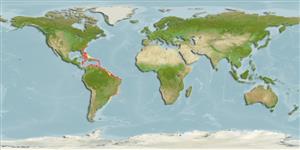Environment: milieu / climate zone / depth range / distribution range
Ecología
marino asociado a arrecife; rango de profundidad 1 - 75 m. Subtropical; 37°N - 33°S, 82°W - 34°W
Western Atlantic: North Carolina, USA and Bermuda to Brazil.
Tamaño / Peso / Age
Maturity: Lm ? range ? - ? cm
Max length : 56.0 cm TL macho / no sexado; (Ref. 26340); common length : 30.0 cm TL macho / no sexado; (Ref. 3815); peso máximo publicado: 680.00 g (Ref. 40637)
The cheek area is usually blue with yellow spots; the blue markings on the scales are more linear; no horizontal blue band above the gill opening, but a dark bluish smudge may often seen behind the upper end of the opening (Ref. 13442).
Adults are frequently found in coral areas, while the young prefer vegetated (e.g. Thalassia), sandy bottoms. Feeds mainly on mollusks, worms, brittle stars, hermit crabs, crabs and sea urchins. Easily approached (Ref. 9710). Marketed fresh and frozen (Ref. 5217).
Life cycle and mating behavior
Madurez | Reproducción | Puesta | Huevos | Fecundidad | Larva
Robins, C.R. and G.C. Ray, 1986. A field guide to Atlantic coast fishes of North America. Houghton Mifflin Company, Boston, U.S.A. 354 p. (Ref. 7251)
IUCN Red List Status (Ref. 130435)
Threat to humans
Reports of ciguatera poisoning (Ref. 30911)
Human uses
Pesquerías: escaso valor comercial
Más información
Nombres comunesSinónimosMetabolismoDespredadoresEcotoxicologíaReproducciónMadurezPuestaAgregación para la puestaFecundidadHuevosEgg development
Herramientas
Special reports
Download XML
Fuentes de Internet
Estimates based on models
Preferred temperature (Ref.
123201): 22.8 - 27.9, mean 26.7 °C (based on 222 cells).
Phylogenetic diversity index (Ref.
82804): PD
50 = 0.5001 [Uniqueness, from 0.5 = low to 2.0 = high].
Bayesian length-weight: a=0.02291 (0.01433 - 0.03663), b=2.93 (2.80 - 3.06), in cm total length, based on LWR estimates for this species & Genus-body shape (Ref.
93245).
Nivel trófico (Ref.
69278): 3.5 ±0.2 se; based on diet studies.
Resiliencia (Ref.
120179): Bajo, población duplicada en un tiempo mínimo de 4.5-14 años (Preliminary K or Fecundity.).
Fishing Vulnerability (Ref.
59153): Moderate vulnerability (42 of 100).
Nutrients (Ref.
124155): Calcium = 22.6 [9.6, 46.7] mg/100g; Iron = 0.517 [0.263, 1.088] mg/100g; Protein = 20 [19, 21] %; Omega3 = 0.167 [0.095, 0.304] g/100g; Selenium = 17.5 [7.7, 36.4] μg/100g; VitaminA = 29 [7, 124] μg/100g; Zinc = 0.63 [0.39, 0.96] mg/100g (wet weight);
